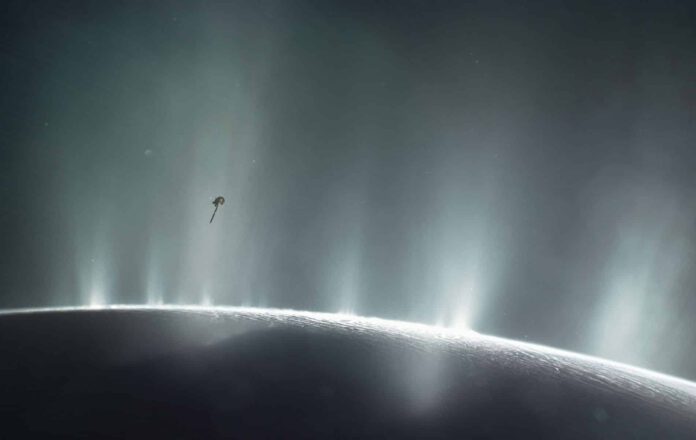
A recent study by scientists has given new hope for the possibility of detecting extraterrestrial life – if it exists on the icy moons of Saturn and Jupiter – during planned flybys.
An introduction to the environment
At first glance, Saturn’s moon Enceladus appears inhospitable; the moon is covered with a thick layer of ice. Yet, many researchers posit that life might lurk beneath, within the ocean hidden under the icy crust. The challenge is verifying this theory. Even where the ice is thinnest, it is estimated to still be about one kilometer thick. Therefore, peeping under the ice is not an option. However, a few years ago, the Cassini spacecraft made an intriguing discovery: significant fissures are present in the ice sheet at Enceladus’ south pole, allowing material from the ocean to escape in the form of ice particles. This prompted scientists to wonder – could a spacecraft sample this material launched into space and determine if it bears traces of life? In a paper published in Science Advances, they propose that the answer might be ‘yes’.
The Findings
“For the first time, we have shown that even a small fraction of cellular material can be identified by a mass spectrometer aboard a spacecraft,” said researcher Fabian Klenner. “Our results give us more confidence that we will be able to detect life forms similar to those we see on Earth, which we increasingly believe may exist on ocean moons.”
The Experiments
Klenner and his team’s conclusions are based on experiments, wherein they replicated ice particles flying through space to test the capability of spacecraft instruments in determining their composition. They were particularly interested in discovering if these instruments could detect life forms, such as bacteria, or traces thereof, present in these particles. Therefore, they conducted experiments with ice particles entrapping bacteria, specifically the Sphingopyxis alaskensis, commonly found in Alaskan waters. They opted for this particular bacterium over the often-used model organism Escherichia coli because it is smaller, survives in cold surroundings, and requires fewer nutrients, making it theoretically more suitable for survival on the icy moons of Saturn or Jupiter and, therefore, ideal for this study.
From Ocean to Ice Particle
But how do bacteria- which are presumed to have a relatively peaceful existence in the subterranean ocean of Enceladus – end up trapped in an ice particle in space? The researchers suggest that bacteria might be present inside cracks in the ice cap at the water’s surface, where they, along with water, are propelled into space as gas bubbles formed in the ocean. These bubbles are a result of the ocean’s exposure to the vacuum of space within the fissures in the ice cap. As the bubbles rise to the surface and burst, they fling bacteria and water into space. Once in space, the water vapor condenses on the organic material and freezes, encapsulating the bacteria within an ice particle.
Implications
“We describe a plausible scenario in which bacterial cells could theoretically be encapsulated in icy material formed from liquid water on Enceladus or Europa (see figure) and then flung into space,” asserts Klenner. If icy moons like Enceladus and Europa are indeed launching bacteria-trapped ice particles into space, it might be a somewhat melancholy situation for the entrapped organisms, but fantastic news for us. The experiments reveal that we should be able to detect these bacteria – or fragments of them – within the ice particles. Researcher Frank Postberg concludes: “With suitable instruments – such as the SUrface Dust Analyzer on NASA’s Europa Clipper – it may be easier than we thought to find life or traces of it on icy moons, assuming life exists there and can be trapped in ice particles originating from an underground water reservoir.”











